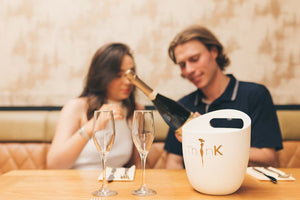Alcohol In Prosecco: A Guide
Mar 31, 2022
Prosecco is the ultimate drink for celebrations, drinks with the girls, and unwinding on Friday afternoon. However, it’s far too easy to drink glass after glass of Prosecco without considering the amount of alcohol in Prosecco.
This is where we can help you out, and inform you all about alcohol in Prosecco. Read on for our guide to alcohol in Prosecco, and to learn more about Prosecco in general, such as what it is, where it comes from, how it tastes, and the calories in Prosecco.
What is Prosecco?
Prosecco is a sparkling wine, first produced in North-East Italy. It is thought to have been enjoyed by the Romans back in 200BC, under the name of Puccino. However, the Prosecco name first appeared in history in 1754 in a poem by Aureliano Acanti.
The North-Eastern area of Italy has produced wine for millennia, with countless vineyards producing delicious wines. Like with any popular wines such as Champagne, Bordeaux, and Burgundy, Prosecco is named after a place. Prosecco is named after the suburb of Prosecco, found in the province of Trieste, Italy. It is produced in a large area, in nine provinces in Friuli Venezia Giulia and the Veneto.
Historically, Prosecco was made using glera grapes which aren’t actually native to Italy - they were brought over by Slovenia. However, in 2009, Italian winemakers decided to remarket the glera grape as Prosecco grapes.
You can find Prosecco in a variety of styles and dryness levels. However, the most popular styles are brut and extra brut. Brut refers to the dryness of the wine - brut means dry, so if you’re looking for a sweeter Prosecco, then you probably won’t enjoy a brut Prosecco.
The three most common dryness levels of Prosecco are brut nature, extra brut, and brut. Brut means ‘dry’ in French. Brut nature is the driest option there is, extra brut means extra dry, and brut is another term for dry, and is a popular type of Prosecco.
How Does Prosecco Taste?
Prosecco is a fresh, crisp, and light-bodied wine, and often has medium to high levels of acidity. This delicious alcoholic beverage is characterised by tasty bubbles - however, you can actually find Prosecco that doesn’t contain bubbles. This is called Tranquillo Prosecco - and can be found in many good supermarkets. It’s a still wine with no bubbles, unlike other types of Prosecco.
Back when Romans enjoyed their version of Prosecco, it was still and didn’t have the classic bubbles. However, this changed when the founder of Carpenè Malvolti winery, Antonio Carpenè added an extra stage to the fermentation process, creating the deliciously bubbly drink we know and love.
Some other types of Prosecco include Spumante and Frizzante - with Spumante being the fizziest.
Some flavours you may notice in a glass of Prosecco may include aromatic apple, peach, melon, honeysuckle, and pear. You may also notice secondary flavours such as hazelnut, cream, and tropical fruits.
As Prosecco is a crisp, dry wine with a moderate level of acidity, it’s not typically a sweet wine. Just because Prosecco is fruity, doesn’t mean that it is sweet. Demi-sec is the sweetest type of Prosecco, so if you prefer a sweeter beverage, you’re sure to prefer demi-sec Prosecco.
Brut Prosecco typically contains between 0-12 grams of residual sugar per litre, extra-dry Prosecco contains between 12-17 grams per litre, and dry Prosecco will contain between 17 and 32 grams of residual sugar per litre.
This makes Prosecco a great choice if you’re trying to lower your calorie intake or maintain a healthy diet. To learn more about the calories in Prosecco, scroll further down the post for our ‘What About Calories in Prosecco’ section.
How Much Alcohol in a Glass of Prosecco?
Most Prosecco contains alcohol - although you can find alcohol-free and low-alcohol Prosecco. This is ideal if you love the flavours and taste of Prosecco but you want to lower your alcohol consumption.
Your standard 125ml glass of Prosecco will usually contain around 1.5 units of alcohol. The recommended alcohol limit per week is 14 units - so if you drink two bottles of Prosecco a week, you’ll be exceeding the recommended weekly amount of alcohol.
As well as units, alcohol in drinks is calculated by the ABV - alcohol by volume. The ABV of wine can be found on the label, or on the menu if you’re in a bar or restaurant. Typically, Prosecco contains between 11% and 13% ABV, but of course, this can vary depending on the brand.
The ABV tells you how much alcohol is in the Prosecco in percentage. This means that the higher the ABV, the more alcohol will be in the drink and the stronger it will be. For example, your typical vodka ABV is 40%, whereas wine is usually around 12%. This is why you can drink several glasses of wine without feeling the effects, but if you drank a glass of vodka, you’d be very, very drunk.
To work out the number of units in a drink from the ABV, you simply multiply the ABV by the ml and then divide by 1000. For example, if you’re enjoying a 125ml glass of 12% ABV Prosecco, then you simply multiply 12 by 125 and then divide by 1000. This will give you the answer of 1.5 - the number of units that you’re consuming. A bottle of Prosecco will typically contain nine units.
When drinking alcohol, it’s important that you make note of what you’re drinking, as it can be easy to go overboard when you’re enjoying wine. Remaining within the recommended amount of alcohol per week can be beneficial to your health in the long term, lowering your blood pressure and reducing the risk of developing certain types of cancer, as well as helping to prevent heart or liver disease.
What About Calories in Prosecco?
Compared to other types of wine, especially full-bodied reds, Prosecco is one of the best beverages if you’re trying to lower or limit your calorie intake.
Your typical glass of Prosecco will contain roughly 1.5g of sugar and around 80 calories per glass of Prosecco - but of course, this depends on the brand and the type of Prosecco that you opt for.
The calories in three glasses of Prosecco roughly equates to the same amount of calories found in a McDonald’s Mayo Chicken Burger.
If you’re looking to lower your calorie intake, opt for dry Prosecco. Brut and extra-brut Prosecco generally contain fewer calories as it is dry and doesn’t have much sugar. Dry Prosecco contains around 60 calories per glass. Sweeter Prosecco, on the other hand, can contain around 120 calories per glass.
At ThinK Wine, you can find delicious low-calorie, low-sugar vegan Prosecco. In fact, we’ve even won awards for the quality of our bubbly - so be sure to check it out today!


